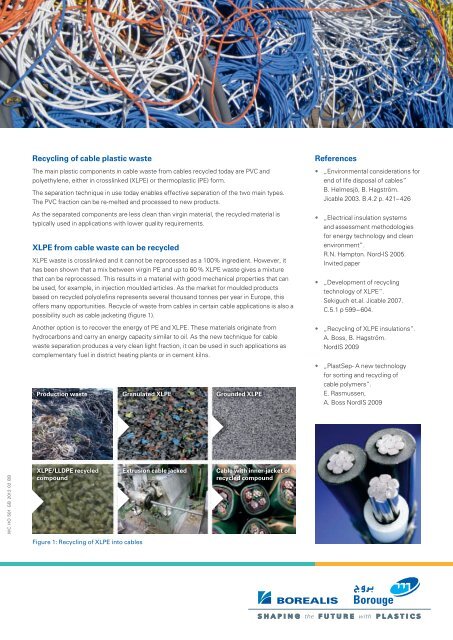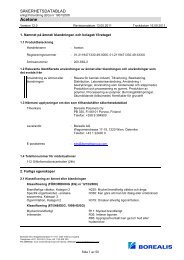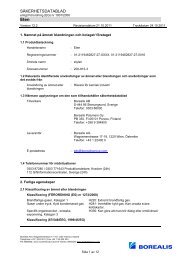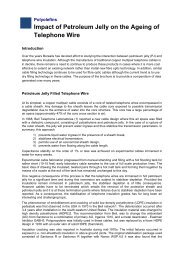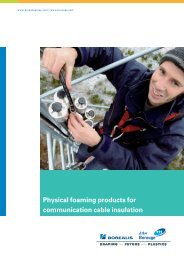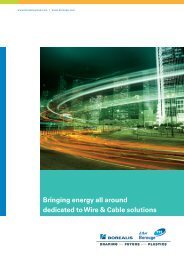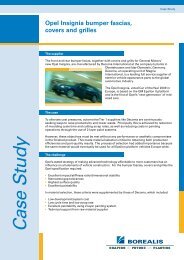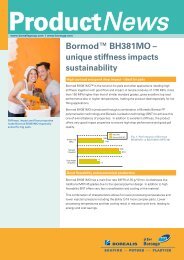Plastic waste from cables - Borealis
Plastic waste from cables - Borealis
Plastic waste from cables - Borealis
Create successful ePaper yourself
Turn your PDF publications into a flip-book with our unique Google optimized e-Paper software.
WC HO 501 GB 2012 02 BB<br />
Recycling of cable plastic <strong>waste</strong><br />
The main plastic components in cable <strong>waste</strong> <strong>from</strong> <strong>cables</strong> recycled today are PVC and<br />
polyethylene, either in crosslinked (XLPE) or thermoplastic (PE) form.<br />
The separation technique in use today enables effective separation of the two main types.<br />
The PVC fraction can be re-melted and processed to new products.<br />
As the separated components are less clean than virgin material, the recycled material is<br />
typically used in applications with lower quality requirements.<br />
XLPE <strong>from</strong> cable <strong>waste</strong> can be recycled<br />
XLPE <strong>waste</strong> is crosslinked and it cannot be reprocessed as a 100% ingredient. However, it<br />
has been shown that a mix between virgin PE and up to 60 % XLPE <strong>waste</strong> gives a mixture<br />
that can be reprocessed. This results in a material with good mechanical properties that can<br />
be used, for example, in injection moulded articles. As the market for moulded products<br />
based on recycled polyolefins represents several thousand tonnes per year in Europe, this<br />
offers many opportunities. Recycle of <strong>waste</strong> <strong>from</strong> <strong>cables</strong> in certain cable applications is also a<br />
possibility such as cable jacketing (figure 1).<br />
Another option is to recover the energy of PE and XLPE. These materials originate <strong>from</strong><br />
hydrocarbons and carry an energy capacity similar to oil. As the new technique for cable<br />
<strong>waste</strong> separation produces a very clean light fraction, it can be used in such applications as<br />
complementary fuel in district heating plants or in cement kilns.<br />
Production <strong>waste</strong><br />
XLPE/LLDPE recycled<br />
compound<br />
Figure 1: Recycling of XLPE into <strong>cables</strong><br />
Granulated XLPE<br />
Extrusion cable jacked<br />
Grounded XLPE<br />
Cable with inner-jacket of<br />
recycled compound<br />
References<br />
• „Environmental considerations for<br />
end of life disposal of <strong>cables</strong>”<br />
B. Helmesjö, B. Hagström.<br />
Jicable 2003. B.4.2 p. 421– 426<br />
• „Electrical insulation systems<br />
and assessment methodologies<br />
for energy technology and clean<br />
environment”.<br />
R.N. Hampton. Nord-IS 2005.<br />
Invited paper<br />
• „Development of recycling<br />
technology of XLPE”.<br />
Sekiguch et.al. Jicable 2007.<br />
C.5.1 p 599 – 604.<br />
• „Recycling of XLPE insulations”.<br />
A. Boss, B. Hagström.<br />
NordIS 2009<br />
• „PlastSep- A new technology<br />
for sorting and recycling of<br />
cable polymers”.<br />
E. Rasmussen,<br />
A. Boss NordIS 2009


